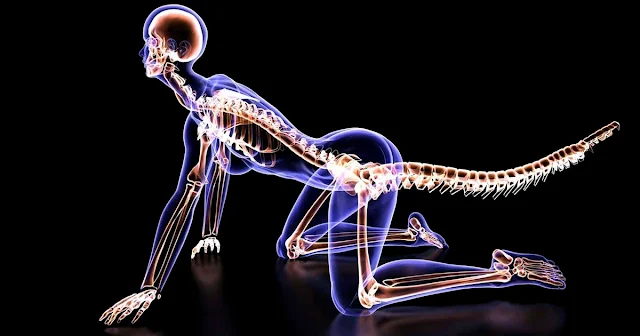One of the most remarkable changes in human evolution is the loss of our tails, a transformation that occurred around 25 million years ago. This pivotal shift not only altered the trajectory of our species but also marked a significant moment in the evolutionary history of primates. While scientists have long speculated on why humans lost their tails, the genetic cause has remained elusive—until now. A recent study published in Nature has finally uncovered the genetic factors responsible for this evolutionary change.

The Quest to Understand Tail Loss
The journey to unravel the mystery of human tail loss began in an unexpected way. Bo Xia, a graduate student at New York University, was inspired to investigate the origins of the human tailbone after injuring his own coccyx. This personal curiosity led Xia and his team to embark on a groundbreaking scientific investigation.
Through careful research, the team focused on the TBXT gene, which plays a crucial role in regulating tail length in various species. Their research revealed a unique genetic mutation within this gene, providing a major breakthrough in understanding human evolution.
The Role of Jumping Genes
A key aspect of this discovery lies in the role of Alu elements, often called “jumping genes.” These genetic elements, specific to primates, can move within the genome and cause significant changes. The researchers found that Alu elements inserted themselves into the TBXT gene, triggering a chain reaction that led to the loss of our tails.
This insertion activated a process known as alternative splicing, where RNA molecules are cut and restructured, which ultimately led to the deletion of a crucial exon. This change altered the structure and function of the resulting protein, leading to the tail loss seen in humans.
Validation Through Mice Studies
To confirm their findings, the researchers engineered laboratory mice with the same genetic mutations found in humans and apes. These genetically altered mice lost their tails, providing compelling evidence that the identified mutation plays a crucial role in the absence of tails in humans and other primates.
However, the study also uncovered a downside to tail loss: an increased risk of neural tube defects, such as spina bifida. This finding highlights the complex balance between evolutionary benefits and potential genetic trade-offs.
The Broader Implications
This discovery has profound implications not just for understanding human evolution, but also for human anatomy and health. The loss of our tails was not a random event but a genetic adaptation with lasting consequences. It illustrates the complex relationship between genetic changes and the way they shape our physiology over time.
As we continue to study our evolutionary past, these findings remind us of the intricate process of natural selection and genetic innovation that has shaped humanity. This breakthrough also underscores the power of scientific inquiry in uncovering the mysteries of our origins, offering insight into the past that can help us understand our future.
The identification of the genetic reasons behind tail loss is a testament to the persistence of scientific exploration and the ongoing quest for knowledge about our evolutionary journey.
Effective Strategies to Reduce Chest and Throat Phlegm and Mucus








Simple Home Remedies to Reduce Phlegm and Mucus in the Chest and Throat
Colds, sneezing, and coughs are common ailments that can leave you feeling drained and uncomfortable. One of the most frustrating symptoms is dealing with persistent mucus that lingers in your chest and throat, often disrupting your daily life and making it difficult to breathe or stay active.
While this issue typically resolves on its own, excessive mucus production can lead to prolonged coughing, throat irritation, and breathing challenges, negatively impacting your quality of life. Fortunately, there are effective remedies you can try at home to help clear mucus and breathe easier.
Understanding Mucus and Why It Accumulates
Mucus is a thick, slippery substance produced by the mucous membranes lining the respiratory tract, including the nasal passages, throat, and lungs. It serves an important role in trapping dust, bacteria, and other foreign particles while keeping airways moist.
However, when mucus production increases due to colds, allergies, respiratory infections, smoking, or exposure to irritants, it can accumulate and become bothersome. This can cause coughing, throat irritation, congestion, and difficulty breathing.
Natural Remedies to Clear Mucus at Home
Instead of immediately turning to medications, consider trying these simple and effective home remedies:
- Stay Hydrated
Drink plenty of fluids throughout the day to thin mucus, making it easier to expel. Water, herbal teas, warm broths, and soups are excellent choices. - Salt Water Gargling
Gargling with a solution of warm water and salt helps reduce throat mucus and soothes irritation. Mix ½ teaspoon of salt in a glass of warm water, gargle for 30–60 seconds, and repeat as needed. - Steam Inhalation
Inhaling steam can loosen mucus and moisten airways. Lean over a bowl of hot water with a towel over your head or use a steam inhaler for best results. - Warm Compress
Applying a warm compress to your chest or throat can help loosen mucus and relieve congestion. Soak a towel in hot water, wring it out, and place it on the affected area. - Honey and Lemon
Mix a tablespoon of honey with warm water or herbal tea, adding a squeeze of fresh lemon juice. Honey soothes the throat, while lemon helps break down mucus. You can also incorporate ingredients like ginger, garlic, or cayenne pepper for added benefits. - Use a Humidifier
A humidifier adds moisture to the air, which can help loosen chest and throat mucus. Clean the humidifier regularly to prevent bacterial buildup. - Nasal Irrigation
Rinsing the nasal passages with saline solution or using a neti pot can help clear mucus and reduce nasal congestion. - Avoid Irritants
Stay away from cigarette smoke, air pollution, and strong chemical odors, as these can worsen mucus production and inflammation.
Practices to Avoid
To effectively manage mucus buildup, steer clear of actions that may aggravate the issue:
- Smoking: Smoking and secondhand smoke increase mucus production and harm the respiratory system.
- Dairy Products: These can thicken mucus, making it harder to expel.
- Sugary Foods and Drinks: Excess sugar can contribute to mucus production and inflammation.
- Overuse of Decongestants: Prolonged use of decongestant sprays can cause rebound congestion.
- Suppressing Coughing: Coughing is a natural way for the body to expel mucus. Avoid overusing cough suppressants unless advised by a healthcare professional.
When to Seek Medical Help
If your symptoms persist, worsen, or are accompanied by other concerning signs such as fever, chest pain, or difficulty breathing, consult a healthcare provider for a proper diagnosis and treatment plan.
By following these simple home remedies and avoiding common triggers, you can manage mucus buildup in your chest and throat, improving your respiratory health and overall well-being.



Leave a Reply